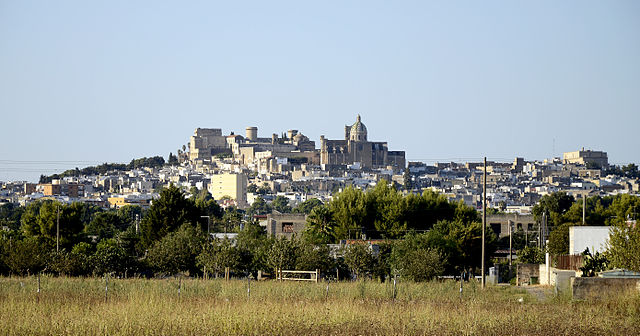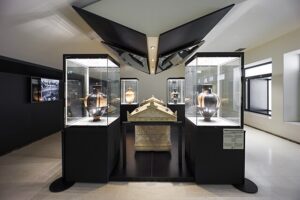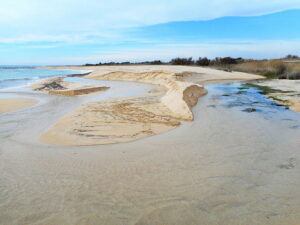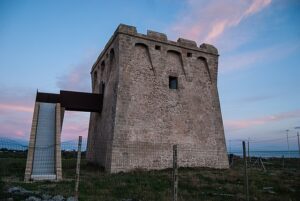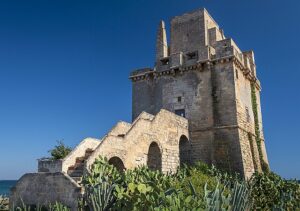The foundation of the city
According to the historian Herodotus, the foundation of the city occurred when a group of Cretans shipwrecked along the Salento coast, not far from Oria. The Cretans chose the highest hill to begin the construction of a new city, as from there they could easily control the surrounding territory. They eventually named the city Hyria, a toponym also widespread in the Aegean area.
Starting from Hyria, these groups of Cretans later colonized the entire Salento region. They were then called, first by the Greeks and later by the Romans, Messapians or Sallentini. Evidence of this Minoan-Cretan influence includes the discovery of Mycenaean pottery.

Coin from Oria, Roman period.
Obverse: Head of Hercules with the lion’s skin on his head.
Reverse: Lightning bolt with the inscription “Orra” above, and the letters “Or” or “TOR” below.
Secondo lo storico oritano Gaspare Papatodero, la fondazione leggendaria di Oria risale all’anno 1007 a.C.
Messapian Period
During the 8th century BC, Oria began its evolution from a scattered settlement to a true city. There was indeed a concentration, likely of huts, on the highest hill of the city, as confirmed by the University of Amsterdam. However, it is not ruled out that the other hills were also sporadically inhabited, although no traces of this have been found. This process of aggregating a settlement in the form of huts on a high hill was common in central and southern Italy at the time, and one of the best examples is undoubtedly the founding of the city of Rome on the Palatine Hill.
Later, around the 6th century BC, it is possible to speak of a true city, with all the characteristics and buildings, both public and temple-related, that define a city. In the earliest dwellings, the use of tiles has also been observed. Also referring to the Archaic period is one of the most important Messapian sanctuaries, the Sanctuary of Monte Papalucio (the current name of the hill where the place of worship stood), where a large number of votive ceramic materials, coins (from the most important cities of the time, such as Metapontum and Sybaris), burnt material, piglet bones, and various plants, associated with the worship of Demeter and Persephone, to whom the sanctuary was dedicated, were found.
Other important archaeological finds from the Messapian period (as well as from the medieval period) were discovered during an emergency excavation conducted by the University of Lecce, during the work to resurface the square in front of the cathedral. On this occasion, the Messapian city wall, dating back to the 5th-4th century BC, and several burial deposits were uncovered.
Oria was one of the major Messapian centers, having contacts with nearly all the most important cities of the time, both Messapian and Magna Graeco. Of particular interest is the relationship, not necessarily the most peaceful, with the nearby and powerful city of Taranto, although there were also periods of flourishing cultural and commercial exchanges.
The rivalry between the Messapians and Taranto reached its peak in 473 BC, when the Tarantini, allied with the Reggini, clashed with the Messapians. The defeat of Taranto and Reggio was devastating, so much so that Herodotus reports: “This was the greatest slaughter of Greeks and Reggini that we know, with 3,000 Reggini soldiers killed and the number of Tarantini dead was impossible to count.” The event had a strong echo throughout the Greek world, to the point that Aristotle specifies that it “occurred shortly after the Persians invaded Greece,” adding that it was also due to this defeat that Taranto shifted its regime from aristocratic to democratic.
Roman Period
This intense conflict weakened both the Messapians and the Tarantini. By 272 BC, Taranto, and soon after the Messapians, lost their independence, at least in part, due to the growing power of Rome. However, Oria did not lose its importance. In 88 BC, it became a Roman municipium and was granted the important privilege of continuing to mint coins. Various types of coins have been found in archaeological excavations: they feature depictions of Eros, the lightning of Zeus, a dove, an eagle grasping a lightning bolt, Hercules with a lion’s skin helmet, and the head of a warrior (with an Epirus-style helmet). The inscription Orra, the Latin name of the city, often appears. The Oria mint had its own distinctive characteristics: such a wealth of iconographic content in the coins is not found in any other Messapian center, as highlighted by scholar E. Travaglini. This shows that the city retained a certain degree of decision-making autonomy. As for the coins depicting the dove, they refer to the worship of Demeter and Persephone in Oria. Furthermore, a demonstration of Oria’s importance is the passage of the Via Appia, very close to the city, considered one of the most important consular roads.
A legend claims that Saint Peter, passing through Oria in 44 AD, preached the Gospel to the people of Oria and consecrated the first bishop. However, there is little concrete evidence of this event, with one notable finding being a bronze plate discovered in the 16th century during work under the ancient Basilian Calogerato. What is certain is that Oria, from the dawn of Christianity, had one of the oldest Christian communities, which later led to the establishment of the episcopal see of Oria, considered one of the most important and ancient in Italy.

